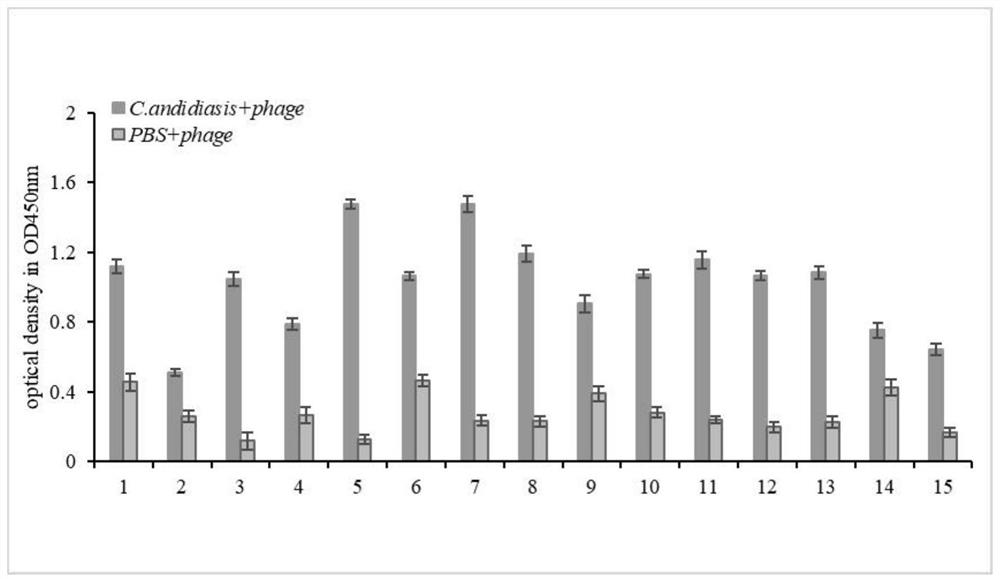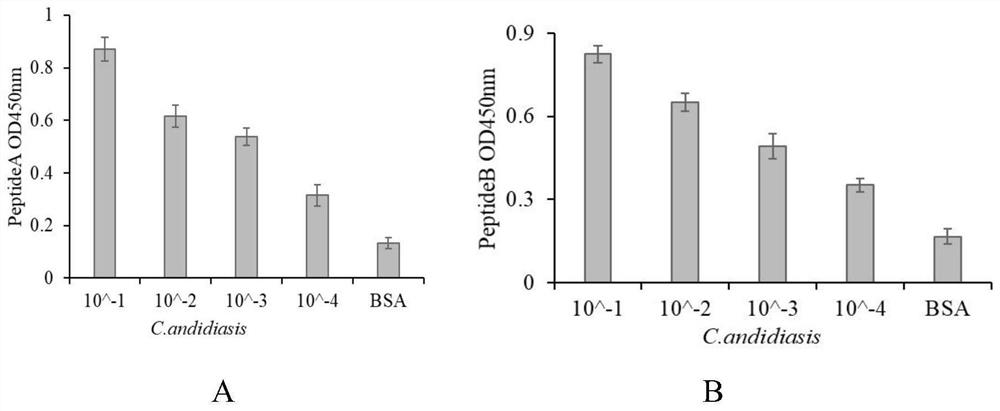Polypeptide for inhibiting proliferation of candida albicans and application of polypeptide in mouthwash
A technology of Candida albicans and mouthwash, applied in peptides, oral care, antifungal and other directions, can solve problems such as large toxic and side effects, many adverse reactions, increased drug resistance reports, etc., and achieve the effect of inhibiting proliferation and preventing oral ulcers
- Summary
- Abstract
- Description
- Claims
- Application Information
AI Technical Summary
Problems solved by technology
Method used
Image
Examples
Embodiment 1
[0029] Screening of polypeptides binding to Candida albicans
[0030] (1) Amplification and purification of phage library: Inoculate a single colony of E.coli ER2738 in 10mL LB liquid medium (10g peptone, 5g yeast extract, 5g NaCl per liter, autoclave, store at room temperature), 37°C , 200rpm shaker and incubate to mid-log phase (OD 600 ≈0.5); add 10 μL of phage, shake at 37°C and 200 rpm for 4-5 hours, centrifuge at 10,000 g for 10 min, and take the supernatant; centrifuge again at 10,000 g for 10 min, take 80% of the supernatant, add 1 / 6 volume of PEG 8000 / NaCl (20 %(w / v) PEG-8000, 2.5mol / LNaCl, autoclaved, stored at room temperature), let stand overnight at 4°C. Take it out the next day, and the white precipitate is the phage. Centrifuge at 10000g for 15min, discard the supernatant, and gently suck out the residual solution after brief centrifugation; add 1mL TBS (50mmol / L Tris-HCl (pH 7.5), 150mmol / LNaCl, autoclaved, store at room temperature) solution to dissolve the w...
Embodiment 2
[0037] Identification of Candida albicans Specific Phage
[0038] Randomly pick 20 well-separated single colonies on the titer determination plate after the third round of screening in Example 1, and after culturing and purifying separately, use phage ELISA to detect the binding activity of each strain of phage to Candida albicans. The specific steps are as follows:
[0039] Coat ELISA plates with Candida albicans and Blocking respectively, each group has three parallels, and block overnight at 4°C, wash 6 times with TBST, add 100 μL of purified phage, incubate with shaking at 37°C for 1 hour, wash 10 times with TBST to remove untreated bacteria. For the bound phage, add 100 μL of HRP-labeled mouse anti-M13 monoclonal antibody, incubate at 37°C for 1 hour with shaking, wash 10 times with TBST, add TMB substrate for 10 minutes at room temperature in the dark, stop the reaction with 2 mol / L sulfuric acid, and measure the OD value at a wavelength of 450 nm , with P / N ≥ 2.1 as po...
Embodiment 3
[0042] Binding Activity Determination of Peptide Sequences
[0043] Coat the plates with different concentrations of Candida albicans and Blocking, block overnight at 4°C, wash 6 times with TBST, and add 2×10 phages with peptide A and peptide B sequences, respectively. 11 (with the same titer of phage without polypeptide A and polypeptide B sequences as the control), wash 10 times with TBST to remove unbound phage, add HRP-labeled mouse anti-M13 monoclonal antibody 100 μL, shake and incubate at 37°C for 1 hour, wash with TBST 10 times; add TMB to react at room temperature in the dark for 10 minutes, stop the reaction with 2mol / L sulfuric acid, and measure the OD value at a wavelength of 450nm. The result is as figure 2 As shown, the phages with polypeptide A and polypeptide B sequences exhibited specific binding to Candida albicans, respectively.
PUM
 Login to View More
Login to View More Abstract
Description
Claims
Application Information
 Login to View More
Login to View More - R&D
- Intellectual Property
- Life Sciences
- Materials
- Tech Scout
- Unparalleled Data Quality
- Higher Quality Content
- 60% Fewer Hallucinations
Browse by: Latest US Patents, China's latest patents, Technical Efficacy Thesaurus, Application Domain, Technology Topic, Popular Technical Reports.
© 2025 PatSnap. All rights reserved.Legal|Privacy policy|Modern Slavery Act Transparency Statement|Sitemap|About US| Contact US: help@patsnap.com



